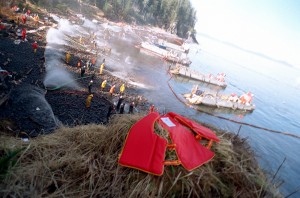By Savannah Volkoff

Last week marked the 25th anniversary of the Exxon-Valdez oil spill in Prince William Sound off the Gulf of Alaska. The anniversary of this accident was commemorated by NPR in a series of reports that explored the economic, social, environmental, political and scientific implications of the spill. This blog will review some of the points of the NPR series, introduce you to two other spills that (ironically) occurred last week and have since attracted media attention, and relate some of the concerns expressed by interviewees to our findings here in the Duke Superfund Research Center.
The spill occurred in the early morning of March, 24, 1989 and the 11 million gallons of crude oil that ended up in the sound, made it the largest oil spill in U.S. history (at the time). Because an event this extreme had never happened in the US, the spill exposed gaps in both regulation and scientific understanding of the consequences of such environmental disasters. The obvious regulatory gaps were filled in the Oil Pollution Act of 1990. Scientific gaps are continuing to be addressed, but research surrounding the environmental impacts of oil spills has expanded because of demand (more oil spills in sensitive environments).
How did the spill cause scientists to think about oil contamination differently?
- some compounds in oil, such as PAHs, may remain in the environment for a long time and can have devastating effects in developing wildlife
- if developing wildlife is affected, there will be population-level consequences for the species
- ecological impacts may persist for years after the spill
- it may not take much oil to produce harmful effects in wildlife
- small concentrations of the oil may not have produced visible deformities, but some negative effects included reduced swimming performance and improperly formed hearts
Two outcomes of the Oil Pollution Act of 1990:
- outlaws single-hull ships from US waters, and required an additional hull for increased protection in collisions
- mandates responsible parties be held accountable for spill clean-up
While research in the Duke Superfund Center doesn’t study crude oil as a contaminant, we are studying PAHs, which are toxic compounds found in oil. We study PAHs in creosote released from wood processing facilities and other industries along the Elizabeth River. Like our work on the Elizabeth River, research from oil spills like the Exxon-Valdez or Deepwater Horizon spill (Gulf of Mexico, 2010) has shown that even low concentrations of PAHs, which can remain in an environment for a long time, can have consequences on developing fish.
Since the heart is one of the first organs that develops in a growing fish, exposure to toxic compounds during early life stages is able to impact the proper development of the heart. Our research findings on the effects of PAHs in creosote complement the findings of researchers studying the ecological effects of oil spills. High concentrations of PAHs induce such severe heart deformities that embryos cannot survive. At lower concentrations of PAHs, the deformities might not be as obvious (or barely noticeable at all) and the fish may survive. But its survival is costly and may reduce its ability to do other tasks well. Swimming performance, for example, is compromised by having an imperfect heart. Poor swimming performance can have other consequences for a wild fish that may affect its survival and ability to reproduce.
Oil spills, and similar anthropogenic environmental disasters, can have devastating effects on wildlife for years after the event. Wildlife populations including fish, shellfish, birds, etc. can experience the effects for generations. The effects may shift where fish are able to live or cause a decline in their population levels. While adaptations to these contaminants are likely possibilities, as evident from our laboratory studies, we are still teasing out the consequences of such adaptations to these fish both at an individual and population level.
In addition to the environmental impacts, NPR reports on the social and economic consequences of the Exxon-Valdez oil spill and how the spill has continued to affect locals 25 years later. Links to those articles are below!
While the Exxon-Valdez spill was the worst at the time, there have since been even more severe spills. The BP Deepwater Horizon spill in 2010 released 5 million barrels or 210 million gallons of oil (see timeline below) into the Gulf of Mexico over the course of 85 days, which makes the Exxon-Valdez spill (coming in at 11 million gallons) look more like a dribble. (Click here for an image comparing the sizes of the two spills.) Last week, reports of two spills were brought to public attention. One spill was from a BP-owned refinery in Indiana. Estimates as of March 28th indicate the incident released 39 barrels (1,638 gallons) of oil into Lake Michigan.
Another spill occurred in Galveston Bay, near Houston, Texas. An estimated 4,000 barrels (168,000 gallons) of oil have been released into the Bay, where people are already scrambling to protect the eggs of sensitive bird populations from oil exposure.
Even though all of these oil spills have influenced and will continue to inform legislation and policymakers, as well as the scientific research with regards to PAHs, oil and wildlife, working to minimize future spills and the addition of contaminants to the environment is important. Scientists recognize there is much more to learn and are continuing to study the molecular effects of PAH exposure to better understand organism and population level effects. Meanwhile others are working on ideas for preventing and responding to future oil disasters.
Timeline of oil spills mentioned in this blog:
Exxon Valdez Source: Exxon Valez oil tanker Responsible Party: Exxon Amount of oil spilled: 11 million gallons Date: March 24, 1989 Length of spill: (NPR, 03/23/14)Gulf of Mexico Source: Deepwater Horizon oil rig Responsible Party: BP Amount of oil spilled: -amount is being negotiated in phase 2 of the multi-district litigation -Government: 5 million barrels, 210 million gallons -BP claims: 3.26 million barrels, 151.2 million gallons Date: April 20, 2010 – July 15, 2010 Length of spill: 85 days (NPR, 03/24/14; BP’s website; TIME interactive timeline of the Deepwater Horizon spill)
Lake Michigan Source: Whiting refinery in Northwest Indiana Responsible party: BP Amount of oil spilled: 39 barrels or 1,638 gallons (as of March 28th) Date: March 24, 2014 Length of spill: 4.5 hours (Chicago Tribune, 03/28/14)
Galveston Bay, Houston, Texas Source: Oil Barge Responsible Party: Kirby Inland Marine Amount of oil spilled: 4,000 barrels or 168,000 gallons Date: March 22, 2014 (NPR, 03/26/14; The Houston Chronicle, 03/23/14)
Links to NPR articles below:
A Dubious Birthday for the Exxon Valdez
Why Oil Drilling is Both Safer and Riskier Since Exxon Valdez
Why the Exxon Valdez Spill was a Eureka Moment for Science
After Oil Spill, Coast Guard Prepares to Open Houston Ship Channel





